l
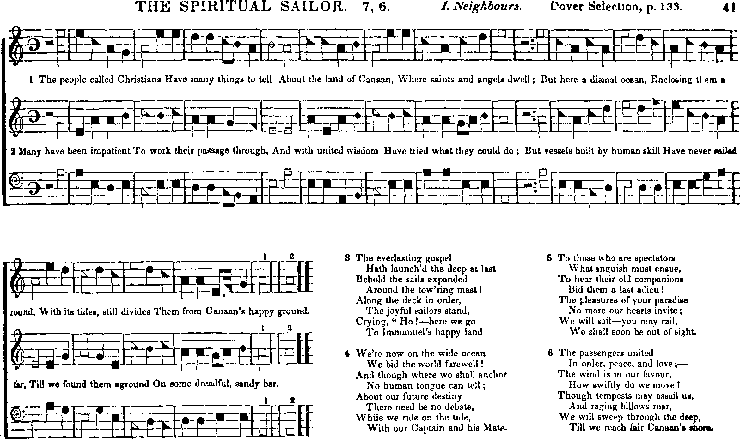
l
|
Maritime
Images In
|
| By John Townley
Presented at the 12th
Annual Mystic Seaport Museum Maritime Music Symposium, June, 1991 Maritime
images,
metaphor, and subject materials have been a major part of popular and
folk
music throughout history, especially during the 17th, 18th, and 19th
centuries
when sea exploration and trans-oceanic conquest were changing the
political and
social structures of the world. The
exploits of ships and sailors were favorite topics for songwriters and
poets
throughout this period and especially toward the end of it, as the tall
ships
faded from everyday humdrum reality into the mists of surreal
romanticism. The
19th century also
saw the heyday of the sailor's work song, or shanty, from about the
time of
Napoleon until the late 1870's when steam began to replace wind and
muscle
power as the main operative power sources aboard ship. During
the hundreds of
years when sea songs of all sorts flourished, maritime imagery was
almost
entirely lacking in one important musical area: Christian
hymnody. Considering how
important this
area has been in
influencing and
cross-germinating pop, folk, and classical music, this would seem to be
quite
an anomaly. Hymns focusing on
maritime
images and metaphors really only enjoyed a very short period of
popularity,
from the middle of the 19th century until the end of World War I. Yet,
during that time, the genre was very
prolific and its writers produced many excellent and moving hymns based
on the
spiritual imagery of the sea. Perhaps
even more anomalistic, almost none of these hymns have survived in
current
usage, and hymn books of the current mainstream church denominations -- Catholic,
Episcopal, Methodist, Baptist,
Presbyterian, Congregationalist, Lutheran, Unitarian --
rarely
contain more than one hymn with a
maritime theme. As a
maritime music
historian who has also been extensively published wearing another hat
in the
area of spiritual matters and the generally ineffable, a special
musical
interest of mine for many years has been sea hymns, and I have amassed
a large
collection of hymn books which contain them. The
attached data base lists the 120 or so which
occur at least once
(though some many times) throughout the collection.
A
glance at the dates show the very narrow temporal
distribution
of the songs, with even those rare earlier tunes often brought into
hymnody by
words written at a later date. I have
noted in earlier papers ["Songwriter Charles Dibdin & 18-19th
Century
Maritime Music" (Mystic, 1985) and"The Influence of 19th Century
Popular
Song On Maritime Music"(Mystic, 1987)] that popular and folk music of
the
sea were rife and intermingled constantly for a much longer period of
time. Why not hymnody,
which otherwise
mixed regularly with pop and folk music across history?
And
why, when maritime imagery did enter the
field, did it happen so intensely and then end so quickly? The
reasons may be
several. First, up until
the 19th
century, the texts of hymns were by custom (and in some cases by church
regulation) taken from the Bible alone, and other sources were excluded. Thus,
the astonishing semi-monopoly on hymn
words held by Isaac Watts, who translated virtually the whole Bible
into
suitable, rhyming hymn quatrains. Under
this sort of stricture, the only maritime imagery available will have
had to
occur originally in scripture. As the
Israelites were not noted for their maritime proclivities, there is
very little
of this in either Old or New Testaments. In
fact, Noah's flood, Jonah and the whale, Jesus's
appearance with the
Apostles on the Sea of Gallilee, and St. Paul's shipwreck pretty much
cover it,
with the exception of an occasional reference to the sea in Psalms and
Ecclesiastes. One
would think at
least these incidents would have cropped up in hymnody, and especially
during
its brief heyday, but they do not. There
is to my knowledge only one hymn about Noah's
flood, and none
about Jonah or St. Paul's shipwreck, despite their detailed
descriptions in the
Bible. The Sea of
Gallilee incident,
however, spawned at least a dozen or so, but only in the brief,
aforementioned
period. Why and how did
this come to
pass? And what did
maritime hymn
authors write about if not these Biblical incidents? In a
search for
answers it is logical to turn to the sea itself and briefly look at the
role of
the church in the life of the sailor in recent historical times. Up
until the 19th century it may be safely
said that organized religion had little impact on the common seaman,
nor did it
attempt to have much. The sailor was
pretty much viewed as a creature beyond the pale and of little interest
or
profit to the church. Sailor songs, pop
and folk alike, in general contain almost no Christian imagery. For
instance, among the over 1500 sea songs
England's most famous pop sea song writer Charles Dibdin penned, God or
Christ
is mentioned in only one of them. Although
Dibdin and others deified the sailor and
the sea in mythic
neo-Classical images, about as close to the Christian God as they get
is in
occasional references to Providence. Folk
songs of the sea also showed not much more
gravitation to
churchgoing. In the 1820's and '30's, however, the attention of evangelists turned toward the sea and soon a large network of seaman's churches or "bethels" came into being at many of the world's major port cities. Whatever their spiritual benefits, the material benefits of these organizations to the common sailor were great indeed. They provided special, safe haven boarding houses where sailors would be free from predatory landlords and land sharks, and they encouraged the traditionally profligate sailor to restrain his appetite for hard liquor and loose women and save money for the sake of creating and supporting a family. The same clergymen helped the fight for decent wages and humane treatment of seamen, the abolition of the lash, and on-board education of seamen in the form of free libraries donated to merchant ships -- the "full fathom" of books, literally two three-foot shelves stocked with a variety of literature and instruction, not just religious in nature. At sea, the sailor could thus pursue his individual education while off watch, and when in port, even when he had no shore leave, floating bethels (in some cases, literally whole church buildings put on barges) would come out to his ship to pursue his moral and spiritual betterment. One
of the more noteable leaders of the seaman's bethel movement was Boston
minister Phineas Stowe, pastor of the First Baptist Bethel Church. He
published the first all-maritime hymns in
1845, entitled Ocean Melodies,
and Seamen's Companion -- A Collection
of
Hymns and Music; For the Use of
Bethels, Chaplains of the Navy, and Private Devotion of Mariners. The
collection contains 64 tunes, with several
sets of lyrics to each tune, providing an extensive variety of hymns
tailor-made for the sailor. The tunes
are mostly traditional hymn tunes of well-known origin or simple folk
tunes
with new sailor lyrics set to them. The
thrust of most of them is the personal image of the sailor tossed upon
the sea
and calling for God's mercy and deliverance from the perils of the
briny
deep. The approach is
strictly from the
point of view of the sailor and the sea imagery is usually literal and
not
metaphorical, as opposed to the later and much more popular gospel
hymns of
post-1870. Except for the
specifically
maritime content of the lyrics, the approach of the hymns is very much
in the
mainstream church tradition. If
there is any one
distiguishing quality about Stowe's collection, it is how
undistiguished it is
lyrically. The imagery,
although
maritime, is very literal and largely uncompelling, with the tunes by
old-time
greats like Thorley often overshadowing the wide variety of trite and
banal
lyrics. Heavyweight hymn
tunes like
Boylston, Coronation, Duke Street, Old Hundred, and Portugal require
the likes
of Isaac Watts to match words to them, and Stowe, who wrote a majority
of the
lyrics, wasn't up to it, even when working with pop tunes like Mary
Derby's
"Bounding Billows" whose original, tragic words of 1792 are so much
more moving than Stowe's little sailor's prayer. Similarly,
adaptations like
"When marshalled on the raging main" for James Millar's 1782
"When marshalled on the nightly plain" deviate just enough from the
original to feel somehow counterfeit and thus lose their intended
impact. Perhaps
because of
this cut-and-paste approach to creating hymns for the sailor, no
memorable ones
were created here or anywhere within the sailor's bethel movement, with
one
notable exception. That is "Jesus,
Savior, Pilot Me," the all-time great which appeared as a poem by New
York
City Church Of Sea And Land minister Edward Hopper in The Sailor's
Magazine in
1871, found its tune later that year, and has graced nearly every
evangelical
hymn book since. In
general, the
mainstream approach to hymn-writing produced very little in the way of
memorable sea hymns, though here again, the exception proves the rule
in the
form of "Eternal Father, Strong To Save," the U.S. Navy hymn penned
in 1860 by William Whiting and set to music (Melita) by none less than
English
composer John Dykes, author of all-time great tunes like "Holy, Holy,
Holy"(Nicea), "Calm On The Listening Ear Of Night"(St. Agnes),
and "Lead, Kindly Light"(Lux Benigna). The
Navy Hymn and "Jesus, Saviour, Pilot Me" remain
virtually the only sea hymns included in mainstream hymnals today. Far and
away the most
-- and best -- sea hymns were created not by mainstream hymn writers
creating
pieces within the fairly static stylistic boundaries of the traditional
church
but by charismatic, high-energy evangelist writers and composers who
created
the "gospel" revival church tradition beginning in the 1870's. Their
musical and poetical approach to the
subject was radically different than earlier writers, and it freed them
to
fully bring the breadth of spiritual symbolism to be found at sea into
the
world of hymnody. Musically,
the gospel
hymn movement, led by internationally-known evangelists and evangelical
composers like Charles Moody, Ira Sankey, P.P. Bliss, Fanny Crosby,
William
Bradbury, Billy Sunday, and Aimee McPherson, made a radical departure
from
traditional hymn writing. Since their
purpose was not to induce spiritual peace but to stir and arouse an
audience,
their tunes usually featured a strong beat and often a pop verse-chorus
format. The sedate church
organ was
supplanted by the tambourine, brass band, and concertina, and church
music
started sounding suspiciously secular -- but, as several composers were
quoted
as saying in their defense, ""Why let the Devil keep all the best
tunes?" The
result was church
music that swung and sometimes was positively toe-tapping.
Hymns
in 4/4 generally had a march beat
overtone, and 3/4 tunes were often seriously danceable.
Some,
like "Remember Me, O Mighty
One," arranged by German pop composer Johanna Kinkel, even changed the
time signature in the chorus for effect. Musically,
this also freed writers of sea hymns to
achieve more rhythmic
effects that could mimic the feel of the rolling sea.
Many
mainstream denominations looked ill upon the
new hymns, as
they saw them for what they were: pop
music in religious guise. Indeed,
gospel hymns were cranked out at a great rate for half a century,
creating hit
hymns and best-selling hymn collections marketed in a very similar
fashion to
the new-born Tin Pan Alley. More
important, however, was the new
lyrical approach the gospel hymn writers adopted. Instead
of singing about the sea and its perils, they sang about
life and its spiritual dangers as if it were the sea.
The
earlier, strictly limited approach of asking for
protection
from the perils of the waves now expanded to a giant metaphor of life
imagined
as a storm-tossed sea. Along with it
went a host of sea metaphors, not all consistent but always picturesque. Most
usual were: The Pilot =
Christ The
evangelists were
not the only ones to try their hands at hymns featuring sea imagery,
but they
were the most successful. Northern
Civil War pop songwriter and publisher George Root (of "Battle Cry Of
Freedom" fame) tried his hand at it -- "Along The River Of Time"
-- and failed miserably. Arthur
Sullivan, without Gilbert, also tried -- "Safe Home In Port" -- with
mediocre results. Even Harriet
Beecher
Stowe got in on the act -- "When Winds Are Raging" -- without lasting
results. Others picked
poetry that was
already a hit and set it to music. There
are three settings for Alfred Tennyson's
"Crossing The
Bar," one of them quite beautiful. But
by
and large, despite forays from famous pop
writers and poets, the
best sea hymns were written by the gospel evangelists. Although
these writers
were not composing for an audience of sailors like Stowe, they were not
entirely unacquainted with the sea and many of their best hymns came
from
personal experiences at sea which they translated to a higher,
spiritual octave
in their songs. One such example
is the
shipwreck incident which led P.P. Bliss to write "Pull For The
Shore." In his own words: "We
watched the
wreck with great anxiety. The
life-boat
had been out some hours but could not reach the vessel through the
great
breakers that raged and foamed on the sandbank. The
boat appeared to be leaving the crew to perish. But
in a few minutes the captain and sixteen
sailors were taken off, and the vessel went down. "'When
the
life-boat came to you, did you expect it had brought some tools to
repair your
old ship,' I said. "'Oh,
no; she was a total
wreck. Two
of her masts were gone and if we had
stayed mending her, only a few minutes, we must have gone down, sir.' "'When
once off
the old wreck and safe in the life-boat what remained for you to do? "'Nothing,
sir,
but just to pull for the shore.'" Bliss
was no mariner,
but he got the point. See the complete words above, right. Since
revival meeting
leaders depended upon hitting especially personal and responsive chords
in
their audiences, their subject matters necessarily reflected the
emotional
attachments of the day. What was it
about this period that caused so many people to be moved by sea
imagery, other
than its obvious effectiveness as a metaphor? I
believe there may be three reasons. First,
the period in
question covers the creation of more new sects of Christianity (and
other
religions as well) than at any other time in modern history. Furthermore,
most were built not on
doctrinal differences, as during the Reformation, but on mystic and
emotional
revelation, of being swept away by the spirit. Of
all available metaphors, emotion and spirituality
are most often connected
with water and water imagery throughout literature, poetry, and
scripture. Thus, for a
period of intense
religious
revival, the very stuff of the sea suggested the flow of the water of
the
spirit which was the basis for the revival itself.
Second,
the audience
for evangelical meetings during this period of time had a unique
attachment to
ships and the sea. This was the
period
of greatest migration to America from Europe, and for several
generations of
millions of people, ships and the sea literally meant a personal
salvation and
a new life. Even if you had
not just
come over on the boat, chances are your parents had or you knew many
others who
had. (It might even be
noted that this
raised maritime consciousness in the Midwest and Western states, where
not many
these days can identify an oar, to its all-time high, since that was
where so
many immigrants settled). It was simply a step further to connect those
emotions born of experience to the spiritual world.
The
number of sea hymns being composed peaked with
the greatest
flow of immigration at the turn of the century and curved down to
virtually
nothing as immigration was radically curtailed by the end of the 1920's. Third,
during this
period developed the first regular, safe use of ships for passenger
transport
and for a reasonable place to work and ply the sailor's profession. Like
never before, ships and the sea were a
part of everybody's life. Not only was
a sea voyage an opportunity to bring passenger or merchant personal or
economic
redemption, the sea and ships were viewed as a kind of career leveller
or clean
slate for the sailors who signed on board. Tales
of bootstrap success starting in the
forecastle by the likes of
Dana and Melville painted the sea as new opportunity to try again,
whatever
your life had been before, facing the challenges of God and nature
instead of
the polluted vicissitudes of the city ghetto. One
step further, and life itself could be viewed
that way, which
perfectly fit the contemporary view of Christian salvation. Together,
these three
reasons helped make the imagery of the sea a "hot button" for over
half a century, after which its special relevance no longer applied,
sea hymn
composition ceased, and most of those which had been previously
composed
dropped away into obscurity. Sea hymns
never caught the imagination of mainstream denominations, and with the
end of
the great revival period and accompanying immigration, religious
society simply
moved on, leaving behind some very beautiful hymns.
This
is not to say that they have been entirely lost
or
forgotten. Many are still to
be found
in the smaller collections of hymns in the pews of charismatic and
revival
churchs around the country, little jewels of devotion beached on the
less
travelled shores of Christian tradition, particularly in the American
South and
Midwest. Although they were not hymns of or for real sailors, they raised the image of the sailor and the sea to a mythical level, very much as the songs of Charles Dibdin had done a century before them. There is simply so much raw emotional and physical symbolism in the sea that society will always paint it as larger than life, just as does the current tall ship revival today. It's the very stuff of romance and inspiration, whether spiritual or secular, and for that reason it has and will continue to inspire beautiful music, poetry, and the intense spiritual and emotional feelings songs and hymns are so well designed to express.
Copyright © John Townley 1989. All rights reserved. |
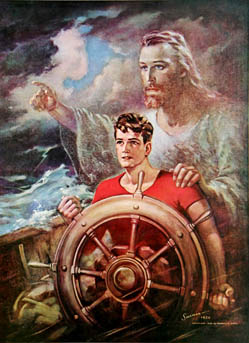
For a century or
more, the
voyage of the
sailor became viewed as a metaphor for the voyage of life across the
seas of sin and temptation and into the harbor of heaven (above). "The Spiritual
Sailor"
(top) is a typical
shape-note effort from 1835.
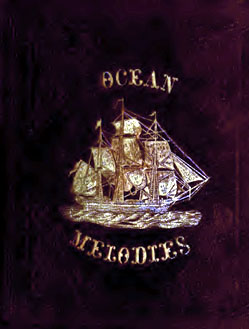
Phineas Stowe's Ocean Melodies was one of the first all-nautical hymnals to be issued for the floating bethels.
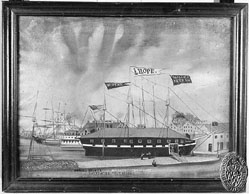
Vessels
were converted
to floating ministries to reach sailors on board ship in local harbors.
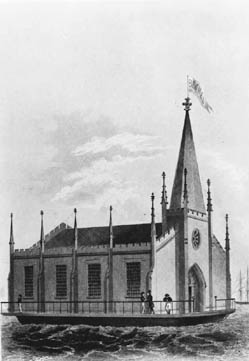
Lacking a vessel, some floating bethels were actual churches simply put on board of a barge and towed to reach their harbor flock, holding services tied up along side visiting ships in the harbor
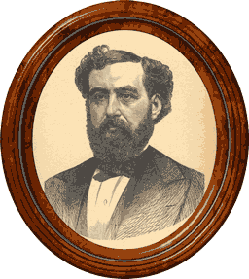
P.P. Bliss was one of the greastest of the maritime gospel hymn composers.
Pull For The Shore
By P.P. Bliss
Light
in the darkness, sailor,
Day is at hand!
See o'er the foaming billows fair,
Fair haven's land.
Drear was the voyage, sailor,
Now almost o'er,
Safe within the lifeboat, sailor,
Pull for the shore!
Pull
for the shore, sailor,
Pull for the shore!
Heed not the rolling waves,
But bend to the oar!
Safe in the lifeboat sailor,
Cling to self no more!
Leave the poor old stranded wreck
And pull for the shore.
Trust
in the life-boat, sailor,
All else will fail,
Stronger the surges dash
And fiercer the gale,
Heed not the stormy winds,
Though loudly they roar;
Watch the "bright and morning star,"
And pull for the shore.
Pull
for the shore, sailor,
Pull for the shore!
Heed not the rolling waves,
But bend to the oar!
Safe in the lifeboat sailor,
Cling to self no more!
Leave the poor old stranded wreck
And pull for the shore.
Bright
gleams the morning, sailor,
Uplift the eye;
Clouds and darkness disappearing,
Glory is nigh!
Safe in the lifeboat, sailor,
Sing evermore
"Glory, glory, hallelujah!"
Pull for the shore.
Pull
for the shore, sailor,
Pull for the shore!
Heed not the rolling waves,
But bend to the oar!
Safe in the lifeboat sailor,
Cling to self no more!
Leave the poor old stranded wreck
And pull for the shore.
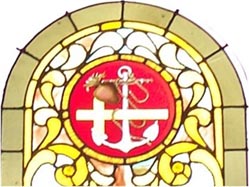
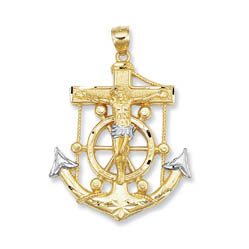
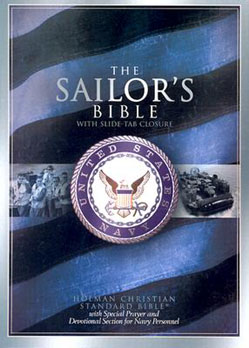
The U.S. Navy still prints its own bible for issue to sailors of Christian persuasion
Sacred Samples
The real experience of maritime hymns is in the singing, and this paper originally had a large collection of example hymns attached to it, for which there is no room here. Fortunately, the Internet abounds with them these days, so here's a list of three dozen to start with. Many are to be easily found, with histories and author biographies, words, music, and MIDI versions of the tunes at the extensive NetHymnal site, some you may have to search for separately:
Boundless Salvation
Cast Thy Bread Upon The Waters
Christ In The Storm
Does Thy Savior Pilot Thee?
Drifting
Drifting Too Far From The Shore
Eternal Father Strong to Save
Fierce Raged The Tempest
Fierce Was The Wild Billow
I Am Anchored Safe
I Feel the Winds of God Today
I've Anchored In Jesus
I've Anchored My Soul
Jesus Lover Of My Soul
Hail Queen Of Heaven
Jesus Savior Pilot Me
Launch Out
Let the Lower Lights Be Burning
Like A Mighty Sea
Lord Be With Us When We Sail
My Anchor Holds
Numberless As The Sands
Oh Lord, Be With Us When We Sail
Old Ship of Zion
Our Life is Like a Stormy Sea
Remember Me, Oh Mighty One
Saved From The Wreck
Send The Light
The Haven of Rest
The Mercy Of God Is An Ocean Divine
The Seaman's Prayer
They That Go Down To The Sea
We Have An Anchor